What Sets Us Apart? Performance
New Fluid Technology (NFT) has again lifted the performance of our SS pumps as reflected in the chart below. Very small pumps are notorious for their low efficiency. NFT’s latest 600w SS spa pumps out perform by far standard 800watt pumps. Graph was published in our customers catalogue which can be downloaded HERE
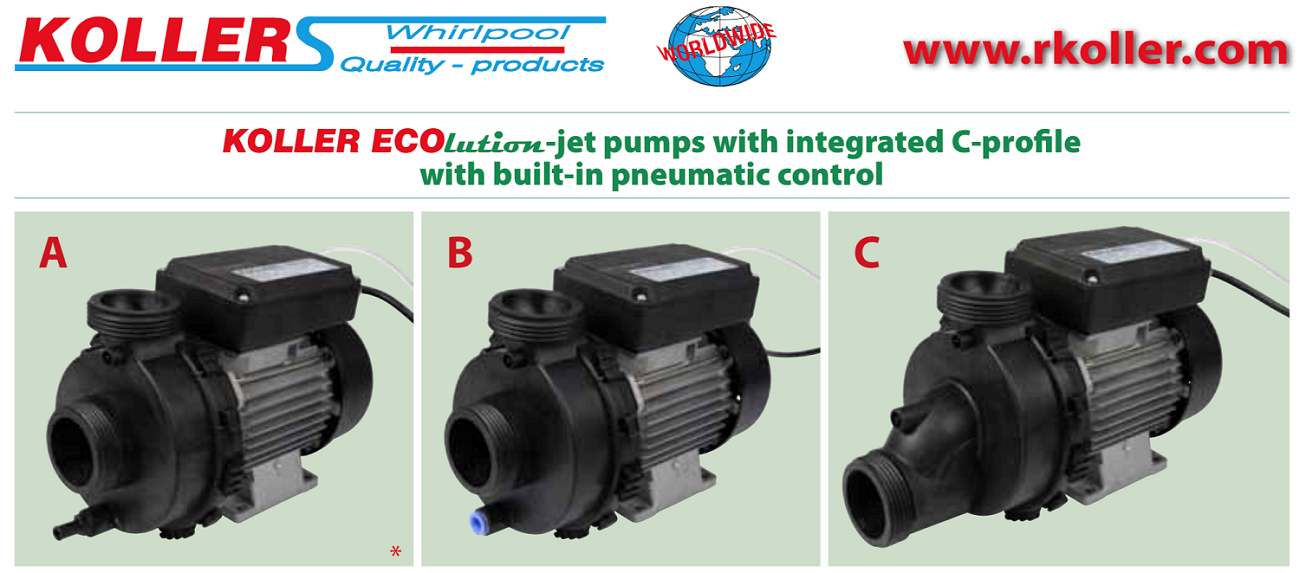
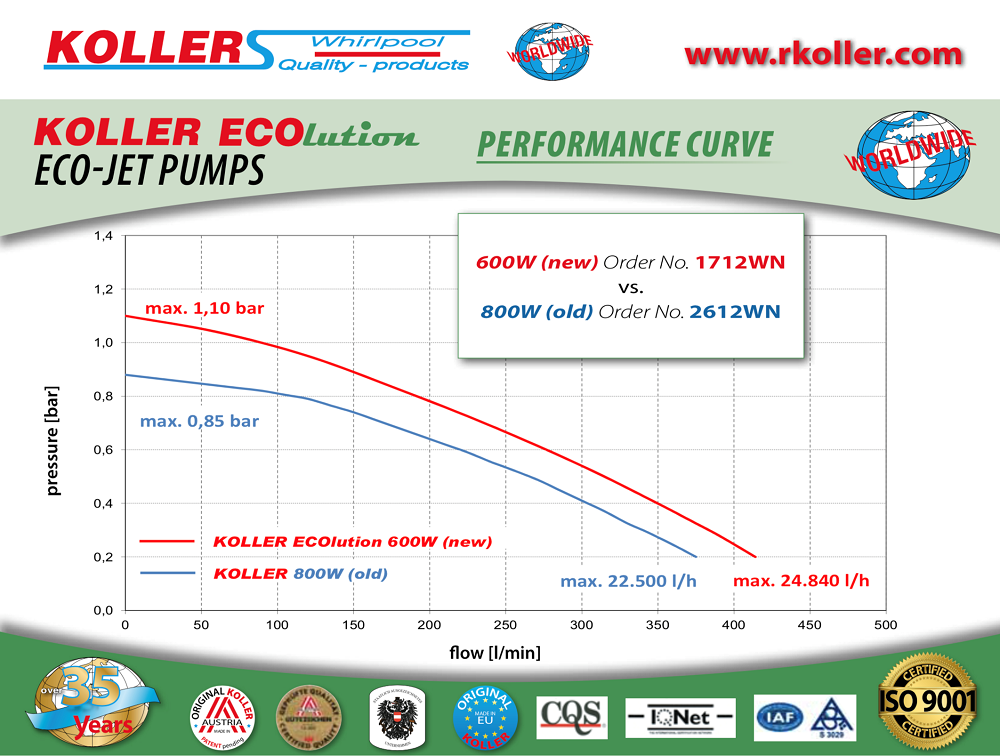
Pumping categories that the Stelth technology applies to and why?
The Stelth Pump is already being manufactured, thus answering the question; can it be manufactured?
Reproducible back to back test results against leading brands, for many different pumping categories, are available.
Noise report available to download shows 8 times lower noise (9dBA less) than same size leading brands. Indicates silent running where desired or essential.
The Stelth Pump has environmental and legislative advantages over competitor centrifugal pumps.
Legislative requirements are forcing conventional centrifugal pump manufacturers to increase efficiency and “energy efficiency”. But they can only increase the motor efficiency and the "system efficiency" by motor’s computer management. The Stelth technology is the “wet” or hydraulic end. Now the two can come together.
Conventional centrifugal water pumps have been around for 200 years, serving us, but with a downside.
There is a need for a new approach to water and air pumping management.
The Supa-Stelth Pump in several differant powersizes is being manufactured in Austria iand Czech Republic.
At right; the SS pumps brochure by Koller whirlpool www.rkoller.com

Koller have manufactured over 50,000 of our SS pumps to date.
The pressure curves in the Koller brochure at right are stylised. The real back to back curves are shown below in Fig 3 below. The Stelth 600 manufactured by Koller curve is also red in Fig 3.
Advances have been made by New Fluid Technology Pty Ltd beyond the above (Red Curve) Koller published performance numbers. Re-producible “back to back” test results for the Stelth against biggest selling brands are available.
All the pump comparison charts are “back to back” and are easy to read.
1. “Wire to Water Efficiency” means; a specific volume of water at a specific pressure, expressed as “watts of water power” divided by the electrical watts into the motor.
2. Total kPA (total kilopascals of pressure) is the sum of the outlet pressure + the inlet negative pressure + the velocity pressure, or dynamic head.
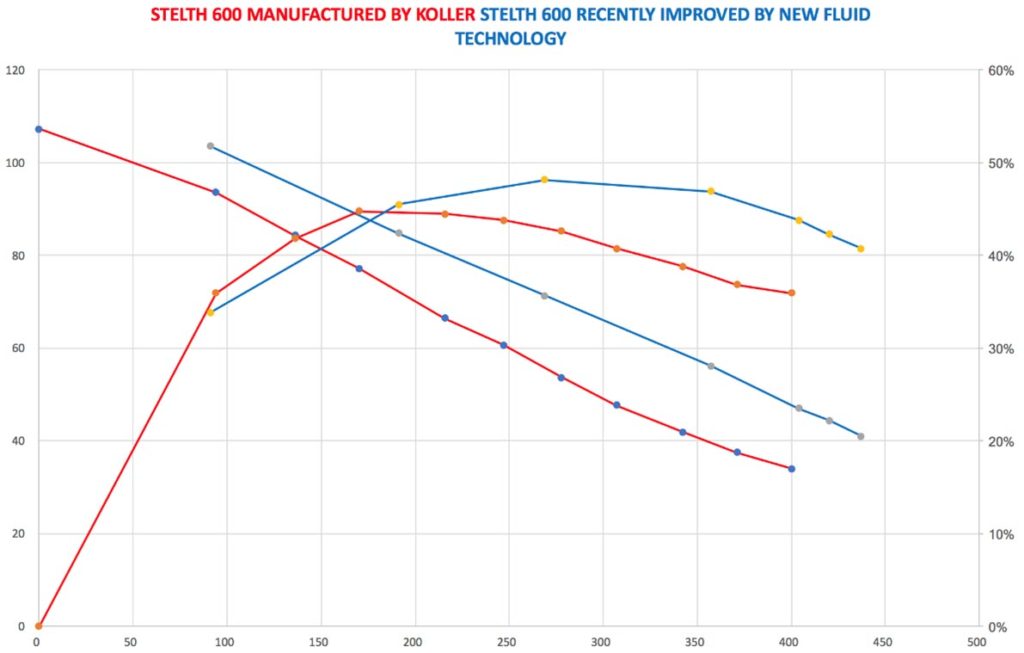
One Supa -Stelth Spa pump can replace three models from LX pumps (of China)
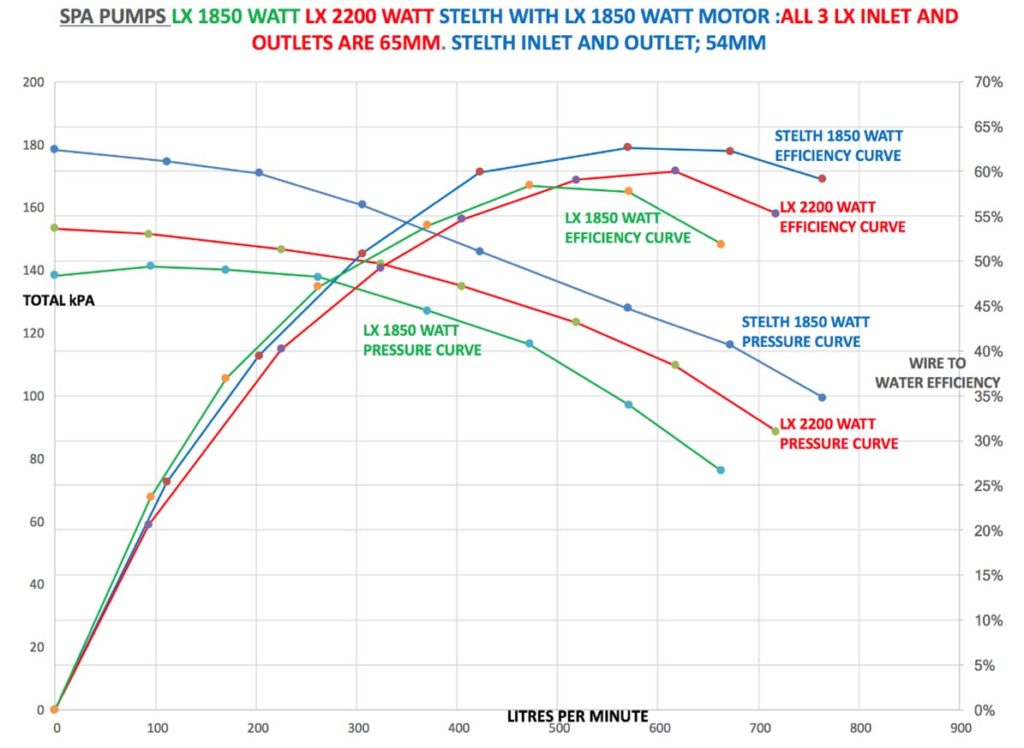
At left, the next chart of Fig 4 is of performance of the Stelth large spa pump versus the LX LARGE SPA PUMP. LX is the world’s largest selling spa pump and acknowledged as the best.
LX make 1500 watt, 1850 watt and 2200-watt spa pumps as well as smaller models.
The graph below shows how the Stelth is able to replace the 3 DIFFERENT SIZES, including 3 different size motors with only one pump and only one motor (one model). The test results are with the Stelth using LX’s 1850-watt motor. Therefore, it can be seen that it is not the motor that makes the performance difference because using the same motor means the Stelth’s “wet end” hydraulic efficiency is higher than the LX pumps.
The Chinese made LX pumps are very high flow/moderate pressure spa pumps and are also ideal for many non-spa applications such as rural/agriculture/cross country pumping plus many more. THE STELTH PUMP SIGNIFICANTLY OUTPERFORMS THE LX FOR EFFICIENCY, NOISE AND MANUFACTURING COST.
Balboa Water, a very large spa bath pump company manufacturer the Hydroair 350 spa pump. Below is a comparison with the Stelth, both employing a single- phase induction motor.
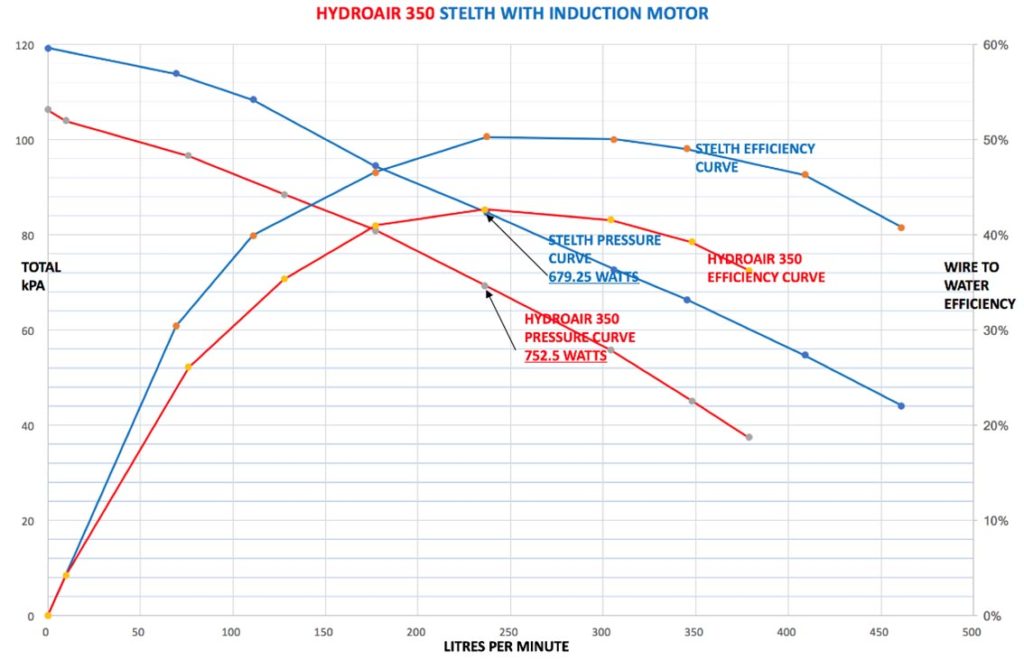
Fig 5 The Hydroair 350 is made by Balboa, a very large spa pump manufacturer.

Fig 6 The Stelth employing a 600-watt motor. And the Hydroair 350 employing a 680-watt motor.
Why is there a need for a new approach to water pumping and air movement?
A new pump is needed by virtually all industries that need to move water. The major reasons are:
1. Public perception is changing toward thinking environmentally, including utilizing renewable energy sources. Consumers may progressively demand products featuring increased “energy efficiency”.
2. The existence of pump manufacturers, without energy efficient products, may be threatened by recent legislative changes in Europe, USA, Australia and others.
3. Even manufacturers whose products are many and varied may find that if only their pump business suffers bad press, it may affect sales of their non-related products due to public suspicion that their company is not environmentally conscious.
4. The world genuinely needs to reduce energy consumption, including electricity usage, to help clean up the planet.
The Stelth pump delivers higher “energy efficiency” than other centrifugal pumps.
Conventional pumps have served us for more than 200 years. But what is their downside?
In the case of conventional centrifugal pumps, one major problem is high noise levels due to water wake collisions with the “cutwater” of volute pumps or otherwise with the blades that define the inlets to the diffusers that the water off the impeller is flung into (pool pumps).
At high RPM, this noise can be unacceptable. Loud noise limits increasing the RPM, especially in a domestic setting.
That noise is a giveaway that those high-speed water wake collisions generate cavitation, which is where the water changes state from liquid to gas (low temperature steam). Any cavitation, anywhere within the pump, results in loss of efficiency including “energy efficiency”. There is a difference between “efficiency” and “energy efficiency”.
The Stelth pump has no “cutwater” or otherwise, multiple diffuser defining blades, as in pool pumps and so there are no wake collisions to generate noise.
Koller tests found the Stelth generated 8 TIMES LESS NOISE than a same size competitor. (9dBA lower sound pressure levels). Click here to download the Koller sound report. Those industries or agencies requiring Stelth running should contact us!
Where conventional centrifugal water-pumps are driven by electric motors, a second problem manifests.
To keep motor costs low, cheap induction motors are employed. These have their RPM controlled by the frequency (Hertz) of the alternating current from the power station.
There is a reason that this is either 60 cycles (Hertz) for USA, delivering practical RPM of about 3,200 to 3,400 RPM and 50 cycles for Europe, UK, much of Asia and Australia, giving RPM of 2,700 RPM to 2,900 RPM (for a two-pole motor).
The silicon iron in induction motors cannot switch magnetic polarity much faster than about 60 times per second or it suffers from certain efficiency losses, generally severe.
Simultaneously, the aforementioned problem with the wet end, or hydraulic part of the pump, also limits a pump’s speed to around 3,400 RPM for sizes covering about 80% of the worlds pumps. Larger pumps must user 4, 6 or 8 pole motors to reduce the RPM so that the problems described above are obviated.
Generally, induction motors, attached to conventional wet ends, are limited to around 3,400 RPM. Conversely, the Stelth pump increases in efficiency as the RPM is increased above those limiting speeds. Conventional pumps may be speed controlled successfully employing newer brushless DC motors, but only from 3,400 RPM down.
The Stelth is able to be speed controlled with increasing efficiency with increasing RPM, so far up to 8,000 RPM, while finding, at present, a very useful speed at 6,000 RPM.
Different RPM’s are because Stelth impeller diameters, so far have been from 275mm down to 40 millimetres. 40 mm obviously requires far higher RPM than larger diameter impellers.
By increasing RPM to above induction motor speeds of 2,900RPM to 3,400 RPM, the Stelth becomes a bigger pump without increasing in physical size, but delivers the big pump’s increased efficiency while remaining a tiny, energy dense, package.
What is the difference between the noise, output and efficiency of Stelth pumps compared to conventional pumps?
The Stelth pump delivers more water than a conventional pump at the same pressure and RPM for both. The pressure developed is a result of the pump opposing the head height or system resistance, both terms being interchangeable.
What are the environmental and legislative advantages of the Stelth pump over existing conventional pumps including energy star rating?
1. The European Union (EU) has introduced legislated pump testing standards as has the USA. Australia has the voluntary AS5102 standard for pool and spa pumps.
2. New Fluid Technology (NFT) has published for years before these legislated changes in Europe, USA and Australia that “best efficiency” (BEP) point on a pump’s pressure curve is not the efficiency of the pump. It is the BEP of the pump and test stand. It is an indicator but by no means the full story.
3.NFT also published years before the changes that pumps virtually never run at their BEP. NFT also published then that “efficiency” was not the same term as “energy efficiency”, the new and legitimate “catch cry” of government legislators and environmentalists.
“efficiency” is “how high the pressure is raised within a given volume of water by means of the pump motor’s shaft power”? There is no consideration of the dollar cost.
The very simple difference between “efficiency” and “energy efficiency” is;
“energy efficiency” is, reducing the money it costs to generate that same volume at the same pressure and it is also used to compare individual pump performances.
Otherwise, by dividing the electrical watts into the water watts, you arrive at the “energy efficiency” because it is electrical watts that cost dollars.
By dividing the pump motor’s shaft watts into the watts of water power you arrive at the “efficiency”.
The pumped water volume multiplied by its pressure, is termed ‘Watts of Water Power”.
The only reason that “energy efficiency” is expressed as litres per watt hour instead of litres per kilowatt hour is that with the latter, the numbers for litres would be too large to go on the same excel chart along with the numbers on the pressure and efficiency axes.
Coinciding with our point 3 above, New EU standards require a pump to be tested at the flow found at its BEP, also at a flow found at 75% of its BEP and also at a flow found at 110% of its BEP. (USA has similar, possibly more stringent, requirements).
This is because it is impossible to match a pump perfectly to any system’s “system resistance”. If you could, then a pump would be running at its “Best Efficiency Point” at all times which would be equivalent to the luck of winning Powerball ten times.
Add to that the fact that as people get in and out of the spa (raise and lower the water level) the efficiency continually shifts right or left of the BEP or in the case of a slowly clogging filter in a pool filtration circuit, the efficiency goes up and down intermittently. That is a reason legislators want to know the energy efficiency of a pump at points either side of its BEP. The pump runs either side of its BEP almost 100% of the time.
In the EU, the energy efficiency scale is designated Minimum Energy Efficiency Index (MEI). In the EU, the best pumps are rated MEI 7. If a pump is forced below MEI 4, it is outlawed.
An awarded MEI number does not indicate the actual energy efficiency of a pump but rather indicates the best performance (MEI 7) to the least allowable (MEI 4). The Stelth, if manufactured in Europe, already achieves MEI 7 for all categories. This may push many down and some to below MEI 4.
The Stelth always has a much broader and usually flatter efficiency curve than conventional pumps and this makes it much more useful when applied to systems with which resistance continually changes.
A short list of pumps that never have a constant flow-rate, pressure or efficiency, is:
- Industrial pumps with filters (that slowly clog)
- Bilge pumps
- Automotive engine cooling pumps
- Pool pumps
- Spa pumps
- Marine pumps throughout ships
- Rural/agriculture pumps
- Dishwashers
- Washing machines
Below are charts produced by the world’s largest pump company ITT, now named Xylem, in their own test lab. The Stelth pump was an early, much lower efficiency pump than the latest Stelth pumps. In the chart, the Stelth clearly is way ahead of the Rule “Mate” (RM2000 in the chart below), which is said to be the world’s largest selling bilge pump. In the below chart, the Stelth clearly is way ahead of the Rule “Mate” (RM2000 in the chart below), which is said to be the world’s largest selling bilge pump.
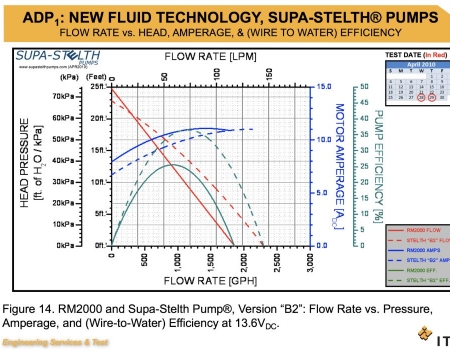
Fig 8 Smaller sized Stelth versus Rule “Mate”
NFT also took the Australian manufactured EWP 115, an automotive engine cooling pump to ITT (Xylem) for back to back testing against the Stelth automotive engine cooling pump. The results are in Fig 9 below. EWP means Electric Water Pump. The Stelth used the same motor as the EWP 115.
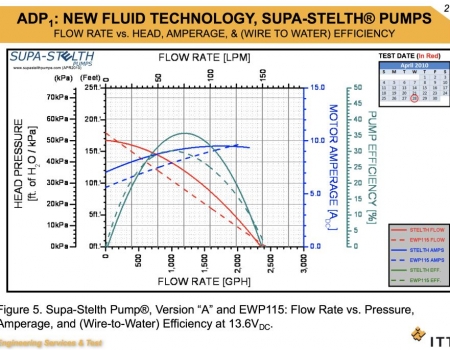
Fig 9 The Stelth and EWP 115 automotive engine cooling pumps tested by ITT
How are conventional pump manufacturers meeting the new energy legislative requirements?
Not by improving the hydraulic or wet end. PLEASE UNDERSTAND THAT!
They are employing newer brushless DC motors that are electronically commutated and the RPM is also “managed” by clever computer programs based on sensing of the flow/pressure situation virtually moment by moment.
A commercial pump has two parts; an electric motor and a “wet end”, the hydraulic part.
THE STELTH PUMP IS THE HYDRAULIC PART ONLY. NO ONE, OTHER THAN NEW FLUID TECHNOLOGY, HAS BEEN ABLE TO IMPROVE THE CENTRIFUGAL PUMP “WET END”.
Manufacturers can only improve the electric motor part of the pump. All good, however;
New Fluid Technology has improved the hydraulic “wet end” performance, an historical event, and in addition, can also utilise the exact same motors and motor controllers.
Energy Stars:
Australia has a voluntary Energy Star rating system for pool and spa pumps, Australian Standard AS5102, which for high efficiency pumps, goes up to 10 stars. An 8-star pump is 25% more energy efficient than a 7-star pump. A 10-star pump is ostensibly 25% more energy efficient than a 9-star pump. “Energy Efficiency” is expressed as “litres per watt hour”. The higher stars, therefore, are much harder to achieve.
World's Highest Performing 10-star pool pump.
THE STELTH PUMP HAS ALREADY ACHIEVED THE HIGHEST LITRES PER WATT HOUR OF ANY POOL PUMP AT ITS PROTOTYPE LEVEL WHILE EMPLOYING A COMMERCIAL POOL PUMP MOTOR.
NFT has been exploring various motors to drive the Stelth pump and can announce, at prototype level, the highest litres pwhr of any pool pump in Australia and therefore in the world (above 67 litres per watt hour at flow and pressure required by Australian Standard AS5102). Work is continuing to lift this even higher).
Why will the Stelth always outperform conventional pumps and better comply with the new legislation?
1. Conventional centrifugal pumps cannot run at high RPM without efficiency loss and noise increase. The Stelth avoids both these and can run at very high RPM with efficiency increasing with increasing rpm.
2. The Stelth delivers better performance than conventional centrifugal pumps while employing the same, low cost induction motors used by all manufacturers, but in addition, can best take advantage of the higher efficiency, brushless DC motors at higher RPM’s than can conventional pumps.
3. By the Stelth delivering higher energy efficiency at higher RPM, the legislators could now increase requirements for pumps to employ higher energy efficient motors, running at increased RPM; RPM’s that conventional centrifugal pump wet ends cannot efficiently run at.
What are the comparison manufacturing costs and selling price of Stelth pumps?
Stelth pumps are simpler to construct and smaller, requiring less plastic or other material.
They are lighter and more compact resulting in lower transportation costs. Because of the higher efficiency, smaller, lower weight motors can be employed, resulting in even lower weight.
This adds up to lower selling cost.

